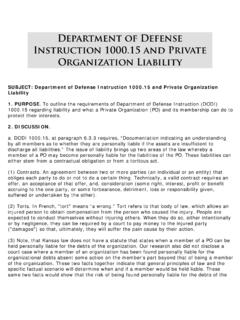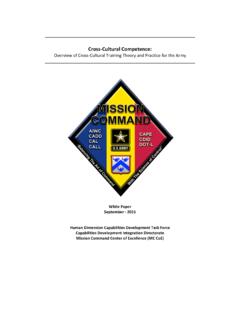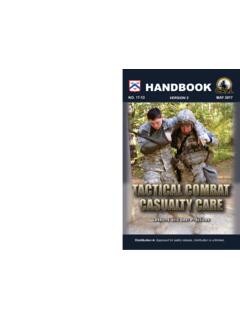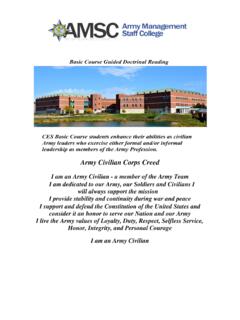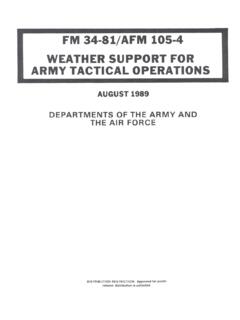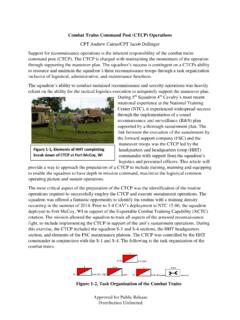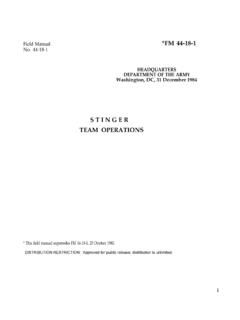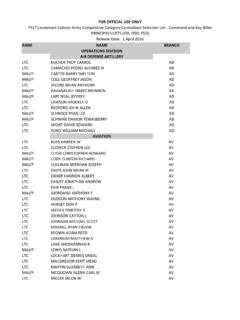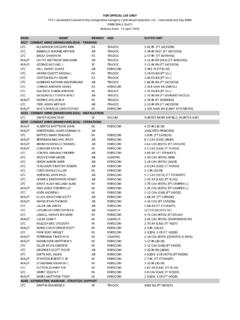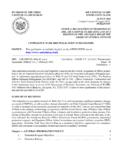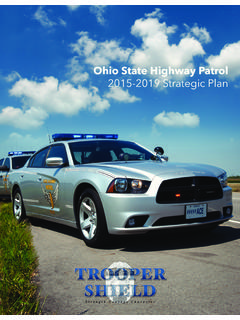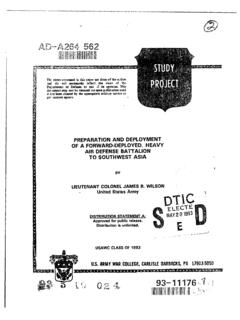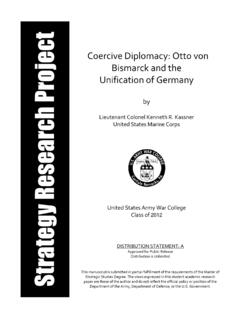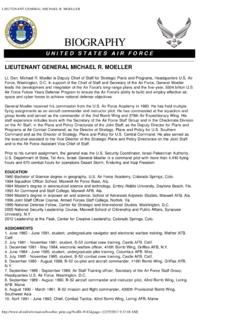Transcription of American Advisors - usacac.army.mil
1 American Advisors Security Force Assistance Model in the Long War By lieutenant colonel Joshua J. Potter, US Army2011 Combat Studies Institute PressCombined Arms CenterFort Leavenworth, KansasAmerican AdvisorsSecurity Force Assistance Model in the Long WarBy lieutenant colonel Joshua J. Potter, US Army2011 Library of Congress Cataloging-in-Publication DataPotter, Joshua. American Advisors : security force assistance model in the long war / by Joshua J. Potter. p. cm. Includes bibliographical references and index. ISBN 978-0-9837226-1-8 (alk. paper) 1. Military assistance. 2. Military assistance, American --Iraq. 3. Military assistance, American --Afghanistan.
2 4. Iraq--Armed Forces--Training of. 5. Internal security--Iraq. 6. Iraq War, 2003- I. Title. 2011 3373--dc23 2011027956 First printing 2011 Abstract: This manuscript describes how US military Advisors prepare for and conduct operations in war. Through two separate year-long combat tours as a military advisor in Iraq, the author brings true vignettes into modern military strategy and operational art. Further, the author provides multiple perspectives in command relationships. Through years of personal experience, direct interviews, and Warfighting knowledge, the author challenges conventionally accepted truths and establishes a new standard for understanding the impact of American Advisors on the modern : The views expressed herein are the sole responsibility of the author and do not necessarily reflect the official views of the Department of Defense (DoD), its Components, or the Joint Center for International Security Force Assistance (JCISFA).
3 CSI Press Publications cover a variety of military topics. The views expressed in this CSI Press Publication are those of the author(s) and not necessarily those of the Department of the army or the Department of Defense. The seal of the Combat Studies Institute authenticates this document as an official publication of the CSI. It is prohibited to use CSI s official seal on any republication of this material without the written permission of the director of CSI. iiiAuthor s NoteAs a Special Forces and Civil Affairs Officer, I spent several years of my military career serving as an American advisor to a Foreign Security Force (FSF). Foreign Internal Defense (FID) proved to be one of the most rewarding experiences I could imagine.
4 Most but not all of the segments and conversations described in this manuscript occurred in 2009-2010 between me and my Iraqi counterpart, who served as the Commanding General of the 17th Iraqi army Division. I consider it an honored privilege to work with warriors of such high caliber and I am eternally grateful for Staff Major General Ali s friendship and mentorship during my fourth tour in Iraq. He convinced me that the Iraqi Nation will prevail on their own terms while benefitting from the countless sacrifices of our American Forces and our families. Through proper application of our advisor programs, we can build the strongest tribe Joint Center for International Security Force Assistance is pleased to introduce American Advisors by lieutenant colonel Josh Potter.
5 Written while serving as the senior advisor to an Iraqi division commander as part of an Advise and Assist Brigade (AAB), this manuscript describes how US military Advisors prepare for and conduct operations in war. Through two, separate year-long combat tours as a military advisor in Iraq, lieutenant colonel Potter offers insights from the tactical operators and their foreign counterparts that capture the observations of the present in order to improve the quality of future American Advisors . Further, the command relationships between the Advisor Team, US Battalion and or Brigade Combat Team (BCT), and the Foreign Security Force are explained from multiple perspectives.
6 This publication is a must read for not only Advisors but leaders of units preparing to conduct SFA and COIN in Iraq or and Assist Brigade Commander Comments by Roger Cloutier, colonel , US army , Commander, 1st Advise and Assist Brigade,3d Infantry Division The US army published the Security Force Assistance (SFA) manual, FM in May of 2009. Slated as the first fully resourced Advise and Assist Brigade (AAB) to deploy into Iraq, the army augmented our Heavy Brigade Combat Team (HBCT) with a full complement of 48 Advisors from December 2009 through December 2010. What lies in the pages that follow is a compendium of experiences from one of the six Iraqi Security Force Divisions we partnered with.
7 Not all were as successful as the 17th Iraqi army (IA) Division but the lessons learned there echoed across the Operating Environment (OE).The role of the AAB Commander is to provide the guidance and operational leadership across the entire formation rather than direct specific action. We were going into the heart of the most dangerous country on the planet and we could not afford any leaders straying from the path. At times I had o interject directly in order to fix a problem, make good on a promise, or crush any idea that we were operating autonomously. We instilled the mantra that As an AAB, we are junior partners in the relationship and that, The ISF success is our AAB success.
8 These thoughts were revolutionary for our type-A personalities to grasp initially but became routine and elementary when we saw the proof that our Iraqi brothers were clearly up to the task. As the Advisors filtered into our formations, we evaluated them on paper, balancing their backgrounds between combat arms and operational support specialties. We tested them during our pre-deployment training scenarios. Following our rotation at the National Training Center (NTC), I talked candidly to my Task Force Commanders in order to see who would best work within the Command. We reformed the Stability-Transition Teams (S-TTs) and integrated them into our formation and guided them each step until they learned to walk in the light of our AAB mission.
9 Then, we monitored them continuously to ensure they stayed on the straight Advisors lived and worked with their counterparts there was no compromise to this, as they had to build rapport and personal relationships with their Iraqi counterparts. In order to promote unity of Command, we had to be creative. The US Task Force Commanders were, at times responsible for partnering with multiple Iraqi Divisions each exceeding 11,000 Iraqi shurta or jundi. We aligned our organization with the existing ISF boundaries, forsaking the traditional use of physical terrain to mark our organizational boundaries. Where other AABs experienced the tyranny of distance, the 1/3 AAB faced the daunting task of partnering with six ISF Divisions and three operational and area commands.
10 In order to meet this challenge, I attached the S-TTs and legacy Military Transition Teams (MiTTs) to the Task Force Commanders. The Task Force Commanders normally provided a Company or Troop in Direct Support to the S-TTs. The MiTTs fell under the Administrative Control (ADCON) of the S-TTs as well. This provided little flexibility for our AAB in terms of uncommitted resources that could flex where we needed especially considering that in the same OE, seven US Brigades once occupied the capital province. viiiOur Soldiers served with distinction and honor during this tour as an AAB and our Iraqi brothers dutifully protected their homes and their people.

